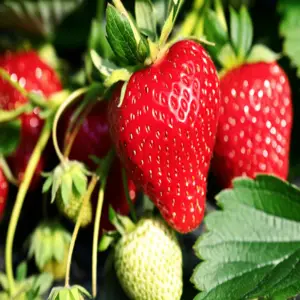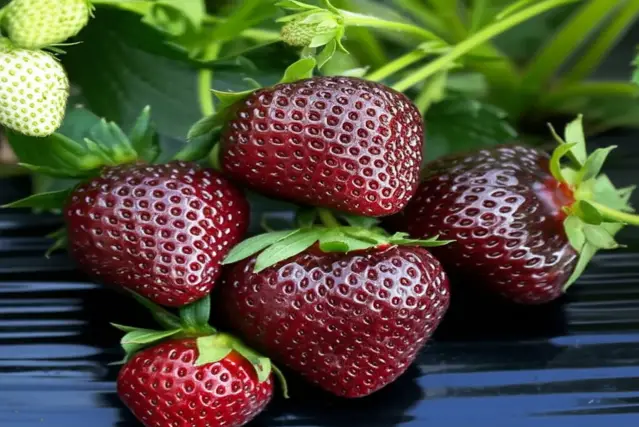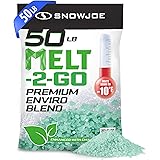Imagine a strawberry, but instead of the familiar bright red, it’s a deep, mysterious black. Sounds intriguing, right? The idea of black strawberries has captured the imagination of many, fueling countless online searches and garden discussions. But are they real? In this comprehensive guide, we’ll delve into the truth behind the “black strawberry” phenomenon, exploring strawberry varieties, similar dark-colored berries, and the latest trends in fruit cultivation in 2025.
Whether you’re a seasoned gardener, a curious foodie, or simply someone intrigued by the unusual, this article will provide you with a complete and up-to-date understanding of this captivating topic. Get ready to uncover the secrets of the elusive black strawberry!
What Exactly are Strawberries? A Quick Botany Lesson
Before diving into the mystery of black strawberries, let’s quickly review what defines a strawberry. Strawberries belong to the genus Fragaria, part of the Rosaceae (rose) family. What we typically consider the “fruit” is actually an enlarged receptacle, the part of the flower that holds the ovaries. The tiny “seeds” on the surface are technically the true fruits, called achenes.
Strawberries are beloved for their sweet flavor, vibrant color, and versatility. They’re enjoyed fresh, in jams, desserts, and even savory dishes. Understanding their basic biology is crucial to understanding why true “black strawberries” are so elusive.
The Myth of the Black Strawberry: Setting the Record Straight
Let’s get straight to the point: True black strawberries, in the sense of a variety with a completely black exterior and interior, do not currently exist. Despite numerous online claims and photos (often digitally altered), no commercially available or scientifically documented strawberry variety is truly black. However, the story doesn’t end there. The quest for black strawberries has led to the development of extremely dark red or purple varieties that are often mistaken for black, and these are the source of much of the confusion.

dark red strawberries
So, where does the misconception come from? Several factors contribute to the myth:
- Misidentification: Dark red or purple strawberry varieties are often labeled as “black” in online marketplaces or garden forums.
- Photo Manipulation: Image editing software makes it easy to darken the color of strawberries in photos, creating convincing but ultimately fake images of black strawberries.
- Wishful Thinking: The idea of a black strawberry is appealing to many, leading to the spread of rumors and misinformation.
- Marketing Hype: Some sellers may exaggerate the darkness of their strawberry varieties to attract customers.
It’s important to be critical of information found online and to rely on reputable sources when researching plants and fruits.
Read More: How to Separate a Monstera: Easy Steps + Care Tips
Exploring Very Dark Strawberry Varieties: The Closest You’ll Get
While true black strawberries remain a myth, several varieties boast exceptionally dark red or purple hues, often appearing almost black under certain lighting conditions. These are the varieties that are most likely to be marketed or perceived as “black strawberries.” Let’s take a closer look at some of the most notable:
Mara des Bois: The Dark French Beauty
Mara des Bois is a French heirloom variety known for its intense flavor and deep red color. While not truly black, the fruit can develop a very dark crimson hue, especially when fully ripe. This variety is a favorite among gourmet chefs and home gardeners alike.
- Flavor Profile: Rich, complex flavor with notes of wild strawberry and raspberry.
- Color: Deep crimson red, sometimes appearing almost black in low light.
- Growing Conditions: Prefers well-drained soil and full sun.
- Availability: Relatively easy to find at nurseries and online seed suppliers.
‘Black Beauty’ Strawberries: A Marketing Mystery
The term “Black Beauty” is sometimes used to describe dark strawberry varieties, but it’s not a standardized cultivar name. Often, strawberries marketed as “Black Beauty” are simply very dark red varieties like Mara des Bois or other similar cultivars. It’s essential to verify the specific cultivar when purchasing strawberries labeled as “Black Beauty” to ensure you’re getting what you expect.
Purple Wonder Strawberries: A Unique and Colorful Choice
Purple Wonder is a unique strawberry variety that develops a deep purple color as it ripens. While not as dark as some of the reddish-black varieties, its distinctive purple hue makes it a visually striking addition to any garden or fruit bowl.
- Flavor Profile: Sweet and slightly tart with a hint of grape.
- Color: Deep purple.
- Growing Conditions: Similar to other strawberry varieties, requiring well-drained soil and full sun.
- Availability: Can be found at specialty nurseries and online seed retailers.
Other Dark Strawberry Possibilities
Smaller farms and local nurseries sometimes cultivate experimental or less common dark strawberry varieties. It’s worthwhile to explore local options and ask specifically about the color characteristics of the available plants. Be prepared for some variation in color based on growing conditions and ripeness.
Remember, the term “black strawberry” is often used loosely, so it’s important to do your research and carefully examine the strawberries you’re considering to ensure they meet your expectations for color and flavor.
Why Are True Black Strawberries So Hard to Find? The Science Behind Strawberry Color
The color of fruits, including strawberries, is determined by the presence and concentration of various pigments. The primary pigments responsible for the red color in strawberries are anthocyanins. The type and quantity of anthocyanins present determine the specific shade of red, from bright scarlet to deep crimson.
To achieve a truly black color in a strawberry, a significant increase in dark-colored anthocyanins would be required, along with a corresponding decrease in other pigments that contribute to lighter colors. This is a complex genetic trait that has proven difficult to achieve through traditional breeding methods.
Furthermore, achieving a stable black color in strawberries might also affect other desirable traits, such as flavor, texture, and disease resistance. Breeders must carefully balance color with other important characteristics to create a commercially viable variety. While breeders might create a strawberry with darker pigmentation, there’s no guarantee that the result will taste good or be a viable plant to grow.
Genetic Modification and Black Strawberries: While traditional breeding has limitations, genetic modification (GM) techniques could potentially be used to create true black strawberries. However, GM technology is subject to strict regulations and public debate, which could limit the development and availability of such varieties. It’s worth noting that the current trend leans towards non-GMO options, further complicating the widespread adoption of GM strawberries, even if they were to be developed. Keep in mind to check the most updated regulations on GMO in your region before purchasing seeds or plants.
Growing Dark Strawberry Varieties: Tips and Tricks for a Successful Harvest
Even though you might not be able to grow “true” black strawberries, cultivating dark red or purple varieties can be a rewarding experience. Here are some tips to help you achieve a bountiful harvest:
Choosing the Right Variety
Select a dark strawberry variety that is well-suited to your local climate and growing conditions. Consider factors such as disease resistance, cold hardiness, and fruit size.
Preparing the Soil
Strawberries thrive in well-drained soil that is rich in organic matter. Amend your soil with compost or other organic materials before planting. Aim for a slightly acidic soil pH of around 6.0 to 6.5.
Planting
Plant strawberry plants in early spring or fall. Space them according to the recommendations for your chosen variety. Ensure that the crown of the plant (where the roots meet the stem) is at soil level.
Watering
Strawberries need consistent moisture, especially during flowering and fruiting. Water deeply and regularly, but avoid overwatering, which can lead to root rot.
Fertilizing
Fertilize strawberry plants in early spring with a balanced fertilizer. Avoid over-fertilizing, which can lead to excessive foliage growth at the expense of fruit production.
Sunlight
Strawberries need at least 6 hours of sunlight per day to produce abundant fruit. Choose a planting location that receives full sun.
Pest and Disease Control
Monitor your strawberry plants regularly for pests and diseases. Take appropriate action to control any problems that arise. Common strawberry pests include aphids, spider mites, and slugs. Common diseases include gray mold and leaf spot.
Harvesting
Harvest strawberries when they are fully ripe and have reached their desired color. Gently pluck the berries from the plant, leaving the green cap and a short stem attached.
Protecting from Birds
Birds love strawberries just as much as we do. Protect your crop with netting or other bird deterrents.
Dark Berries Beyond Strawberries: Exploring Other Options
If you’re fascinated by the idea of dark-colored berries, you’ll be pleased to know that there are many other options available. Here are some notable examples:
Blackberries: The Classic Dark Berry
Blackberries are a popular and widely available dark berry. They are known for their sweet-tart flavor and versatility. Blackberries are delicious fresh, in jams, pies, and other desserts.
Black Raspberries: A Unique and Flavorful Choice
Black raspberries are similar to red raspberries but have a darker, almost black color. They have a more intense flavor than red raspberries and are often used in jams and preserves.
Elderberries: A Medicinal and Culinary Powerhouse
Elderberries are small, dark berries that are known for their medicinal properties. They are often used to make syrups, jams, and wines. Elderberries should be cooked before consumption, as raw berries can be toxic.
Huckleberries: A Wild and Delicious Treat
Huckleberries are small, dark berries that are native to North America. They are similar to blueberries but have a more intense flavor. Huckleberries are often found in the wild and are a favorite among hikers and foragers.
Acai Berries: An Exotic Superfood
Acai berries are small, dark berries that grow on palm trees in the Amazon rainforest. They are known for their high antioxidant content and are often marketed as a superfood. Acai berries are typically consumed in smoothies, juices, and other beverages.
Mulberries: A Sweet and Juicy Delight
Mulberries are often overlooked, but these dark berries are incredibly delicious and easy to grow. They can be found in different colors from white to dark purple/black. Black mulberries (Morus nigra) are particularly prized for their intense, sweet-tart flavor. They make excellent jams, pies, and can be enjoyed fresh. Be aware that mulberry trees can be messy, dropping berries that stain surfaces, so choose your planting location carefully.
These are just a few examples of the many dark-colored berries available. Explore different options and find the ones that best suit your taste and growing conditions.
The Future of Strawberry Breeding: Will We Ever See True Black Strawberries?
The quest for new and improved strawberry varieties is an ongoing process. Strawberry breeders are constantly working to develop varieties that are more flavorful, disease-resistant, and productive. While the creation of true black strawberries remains a challenge, advancements in breeding technology may eventually make it possible.
CRISPR Technology and Strawberry Color: CRISPR (Clustered Regularly Interspaced Short Palindromic Repeats) is a revolutionary gene-editing technology that allows scientists to precisely modify the DNA of organisms. CRISPR could potentially be used to manipulate the genes responsible for anthocyanin production in strawberries, leading to the creation of truly black varieties. However, as with GM technology, CRISPR-edited plants face regulatory hurdles and public perception concerns.
Marker-Assisted Selection: Marker-assisted selection (MAS) is a breeding technique that uses DNA markers to identify plants with desirable traits. MAS can accelerate the breeding process by allowing breeders to select plants with the desired color characteristics at an early stage. This method can help to identify and isolate plants with genes that promote increased production of darker pigments.
Consumer Demand and Market Trends: Consumer demand for unique and visually appealing fruits is driving innovation in the fruit breeding industry. If there is sufficient demand for black strawberries, breeders may be more likely to invest the resources necessary to develop them. *_Keep an eye on market trends and consumer preferences, as these can significantly impact the direction of fruit breeding._* The rise of “Instagrammable” foods and the desire for novel culinary experiences are potential drivers for increased interest in unique fruit colors.
The impact of climate change: It’s important to consider how climate change might affect strawberry breeding programs. As environmental conditions shift, breeders will need to prioritize traits like heat tolerance, drought resistance, and disease resistance. These challenges may divert resources away from purely aesthetic goals like developing black strawberries.
It’s difficult to predict exactly when or if true black strawberries will become a reality. However, ongoing research and advancements in breeding technology offer hope for the future.
Read More: How Often To Water Pothos: The Ultimate Guide
Black Strawberry Recipes (Using Dark Strawberry Varieties)
While you wait for the elusive true black strawberry, you can still enjoy the visual appeal and unique flavor of dark strawberry varieties in various recipes. Here are a few ideas:
Dark Strawberry Jam
Use Mara des Bois or other dark red strawberry varieties to create a jam with a rich, deep color and intense flavor.
Ingredients:
- 4 cups crushed dark strawberries
- 4 cups sugar
- 1/4 cup lemon juice
- 1 package pectin (optional, for thicker jam)
Instructions:
- Combine strawberries, sugar, and lemon juice in a large pot.
- If using pectin, add it according to package instructions.
- Bring the mixture to a rolling boil over medium-high heat, stirring constantly.
- Continue boiling until the jam reaches the desired consistency, about 10-15 minutes.
- Ladle the hot jam into sterilized jars, leaving 1/4 inch headspace.
- Process the jars in a boiling water bath for 10 minutes to ensure proper sealing.
Dark Strawberry Tart
A classic dessert that showcases the beautiful color of dark strawberries. Use a pre-made or homemade tart shell and fill it with a creamy custard or pastry cream. Arrange the strawberries on top in an attractive pattern and glaze with apricot jam.
Dark Strawberry Salad
Add sliced dark strawberries to a salad with baby spinach, goat cheese, candied pecans, and a balsamic vinaigrette for a refreshing and flavorful dish.
Dark Strawberry Smoothies
Blend dark strawberries with yogurt, milk, and other fruits for a healthy and delicious smoothie. The dark color will add a unique visual appeal to your drink.
Dark Strawberry Salsa
Combine diced dark strawberries with red onion, jalapeno, cilantro, lime juice, and a touch of honey for a sweet and spicy salsa that pairs well with grilled meats or tortilla chips.
Black Strawberry Benefits (From Dark Varieties)
While true black strawberries don’t exist, the dark varieties like Mara des Bois and Purple Wonder offer many of the same health benefits as other strawberries, and potentially even more due to their higher anthocyanin content. Anthocyanins are powerful antioxidants that are responsible for the deep colors in these berries. *_It’s important to consult a healthcare professional for specific health advice._*
- Rich in Antioxidants: Anthocyanins help protect the body against damage from free radicals, reducing the risk of chronic diseases.
- Supports Heart Health: Studies suggest that anthocyanins can improve blood vessel function and lower blood pressure.
- Boosts Brain Function: Some research indicates that anthocyanins can enhance memory and cognitive function.
- Anti-Inflammatory Properties: Anthocyanins have anti-inflammatory effects that may help reduce symptoms of arthritis and other inflammatory conditions.
- Good Source of Vitamins and Minerals: Strawberries are a good source of vitamin C, manganese, and fiber.
Incorporating dark strawberry varieties into your diet can be a delicious and nutritious way to support your overall health.
Current Trends and Statistics in Strawberry Production (2025)
The strawberry industry is a significant part of the global agricultural market. Here’s a look at some of the current trends and statistics:
Global Production
China is the world’s largest producer of strawberries, followed by the United States. Other major strawberry-producing countries include Mexico, Egypt, and Spain. The overall global production has been increasing steadily in recent years due to growing demand and improved farming techniques.
Market Trends
- Increased Demand for Organic Strawberries: Consumers are increasingly seeking out organic strawberries due to concerns about pesticides and environmental sustainability. The organic strawberry market is growing at a faster rate than the conventional strawberry market.
- Growing Popularity of Locally Grown Strawberries: Consumers are also interested in supporting local farmers and reducing their carbon footprint by purchasing locally grown strawberries. Farmers markets and community-supported agriculture (CSA) programs are becoming increasingly popular outlets for local strawberry growers.
- Development of New Strawberry Varieties: Strawberry breeders are constantly working to develop new varieties that are more flavorful, disease-resistant, and adapted to specific growing conditions. There is also a growing interest in developing varieties with unique colors and shapes.
- Technological Advancements in Strawberry Farming: Strawberry farmers are adopting new technologies such as precision irrigation, automated harvesting systems, and vertical farming to improve efficiency and reduce costs.
Statistics
Data changes frequently, so keep in mind these are estimates and may vary based on the source.

unusual strawberry varieties
| Category | Statistic |
|---|---|
| Global Strawberry Market Size (2025 Estimate) | Approximately $15-20 billion USD |
| Projected Growth Rate (2024-2029) | Around 4-6% CAGR (Compound Annual Growth Rate) |
| Leading Strawberry Producing Countries | China, United States, Mexico, Egypt, Spain |
| Percentage of Organic Strawberries Sold in the US | Approximately 15-20% (and growing) |
These trends and statistics highlight the dynamic nature of the strawberry industry and the ongoing efforts to meet consumer demand and improve production practices.
Regulations Regarding Strawberry Cultivation and Sales (2025)
Strawberry cultivation and sales are subject to various regulations at the local, national, and international levels. These regulations cover aspects such as pesticide use, food safety, plant health, and labeling.
Pesticide Regulations
The use of pesticides in strawberry farming is regulated by government agencies such as the Environmental Protection Agency (EPA) in the United States and similar bodies in other countries. These agencies set limits on the types and amounts of pesticides that can be used on strawberries to protect human health and the environment. Farmers must follow strict guidelines for pesticide application and record-keeping.
Food Safety Regulations
Strawberries are considered a high-risk food for foodborne illnesses due to their consumption fresh and their susceptibility to contamination. Food safety regulations such as the Food Safety Modernization Act (FSMA) in the United States require strawberry growers to implement practices to prevent contamination during production, harvesting, and processing. These practices include proper hygiene, sanitation, and water management.
Plant Health Regulations
Plant health regulations are designed to prevent the spread of plant pests and diseases. Strawberry plants must be inspected and certified to ensure they are free from diseases before they can be sold or transported. Quarantines may be imposed on areas where certain strawberry diseases are present.
Labeling Regulations
Strawberry labeling regulations require that strawberries be labeled with information such as the variety, origin, and grade. Organic strawberries must be labeled according to organic certification standards. Labels must be accurate and not misleading to consumers.
International Trade Regulations
The international trade of strawberries is subject to regulations such as tariffs, quotas, and phytosanitary requirements. These regulations are designed to protect domestic industries and prevent the introduction of plant pests and diseases from other countries.
Local Regulations
It is important to also consider local regulations, which can vary widely depending on the region. These may include zoning laws, water usage restrictions, and regulations on the sale of agricultural products at farmers’ markets.
Staying informed about these regulations is crucial for strawberry growers and sellers to ensure compliance and avoid penalties.
Debunking Black Strawberry Myths
Let’s address some common myths and misconceptions surrounding black strawberries:
- Myth: Black strawberries are a newly discovered species.
- Truth: No “new” species of black strawberries have been discovered. The term “black strawberry” usually refers to very dark red or purple varieties.
- Myth: Black strawberries taste like black licorice.
- Truth: The flavor of dark strawberry varieties is generally similar to other strawberries, with perhaps a slightly more intense or complex flavor profile. They do not taste like black licorice.
- Myth: Black strawberries are poisonous.
- Truth: Dark strawberry varieties are not poisonous and are safe to eat.
- Myth: Black strawberries are GMO.
- Truth: Currently, there are no commercially available GMO strawberries marketed as “black.” While genetic modification could potentially be used to create black strawberries, it is not the current method of choice.
- Myth: If you plant regular strawberry seeds, you’ll get black strawberries.
- Truth: Planting seeds from store-bought strawberries will not necessarily produce the same variety. Strawberries are often hybrids, and their seeds may not breed true. You are unlikely to get “black strawberries” from these seeds.
By understanding the facts and dispelling these myths, you can make informed decisions about your strawberry purchases and gardening efforts.

rare strawberry fruit
Resources for Further Research
If you’re interested in learning more about strawberries and other berries, here are some resources that you may find helpful:
- University Extension Services: Contact your local university extension service for information on strawberry cultivation in your area.
- Agricultural Research Organizations: Explore the websites of agricultural research organizations such as the USDA Agricultural Research Service for scientific information on strawberry breeding and production.
- Gardening Books and Magazines: Consult gardening books and magazines for tips on growing strawberries and other berries.
- Online Gardening Forums: Participate in online gardening forums to connect with other gardeners and share information.
- Nurseries and Seed Suppliers: Browse the websites of reputable nurseries and seed suppliers for information on strawberry varieties and growing tips.
- Academic Journals: Academic journals in the fields of horticulture, plant science, and food science provide detailed research on strawberry breeding, genetics, and nutrition.
FAQ About Black Strawberries
Are black strawberries real or just a myth?
True black strawberries, meaning completely black inside and out, don’t exist commercially. The term usually refers to very dark red or purple varieties.
What varieties of strawberries are often mistaken for black strawberries?
Mara des Bois, Purple Wonder, and some strawberries marketed as “Black Beauty” are often mistaken for black strawberries due to their very dark coloration.
Why are true black strawberries so difficult to create?
Achieving a truly black color requires a complex combination of pigments and genetic factors, which is difficult to achieve through traditional breeding methods. It could also impact other desirable traits like flavor and texture.
Can I grow “black strawberries” in my garden?
You can grow dark red or purple varieties like Mara des Bois or Purple Wonder, which may appear almost black under certain lighting conditions. These can be found at many nurseries or online seed suppliers.
What are anthocyanins, and why are they important for strawberry color?
Anthocyanins are pigments responsible for the red, purple, and blue colors in fruits, including strawberries. The type and concentration of anthocyanins determine the specific shade of color.
Do dark strawberry varieties have any health benefits?
Yes, dark strawberry varieties are rich in antioxidants, particularly anthocyanins, which have been linked to heart health, brain function, and anti-inflammatory effects.
Are there any GMO black strawberries available?
No, there are currently no commercially available GMO strawberries marketed as “black.”
What are some other dark-colored berries I can grow in my garden?
Blackberries, black raspberries, elderberries, huckleberries, and mulberries are all excellent options for dark-colored berries that you can grow in your garden.
How can I tell if a strawberry is truly dark or just artificially colored in a photo?
Be wary of photos that look overly saturated or unrealistic. Look for natural lighting and examine the details of the strawberry’s surface. Reputable nurseries will provide accurate descriptions and photos of their varieties.
What are the latest trends in strawberry breeding and production?
Current trends include increased demand for organic and locally grown strawberries, development of new varieties with unique colors and flavors, and technological advancements in farming practices like precision irrigation and automated harvesting.
Conclusion: Final Thoughts on the Black Strawberry Phenomenon
The quest for the elusive black strawberry, while currently unfulfilled in its purest form, highlights our fascination with the natural world and our desire for unique and visually appealing foods. While true black strawberries, with their completely dark pigmentation, may not be a reality in 2025, the journey has led to the discovery and cultivation of incredibly dark red and purple varieties that offer a tantalizing glimpse into what might be possible in the future.
The dark strawberry varieties that *do* exist, like the Mara des Bois and Purple Wonder, provide a delightful compromise, offering a beautiful aesthetic and a complex flavor profile that sets them apart from more common red strawberries. Furthermore, these berries are packed with health-boosting antioxidants, making them a nutritious addition to any diet.
As we’ve explored, advancements in breeding technologies like CRISPR and marker-assisted selection hold the potential to create true black strawberries in the future. However, the development of such varieties must also consider factors like consumer demand, regulatory hurdles, and the impact on other desirable traits like flavor, disease resistance, and sustainable farming practices. The focus may shift towards more pressing concerns such as adapting strawberries to climate change rather than solely focusing on color.
In the meantime, let’s celebrate the dark strawberry varieties we *can* enjoy, and continue to appreciate the beauty and diversity of the plant kingdom. Whether you’re a seasoned gardener, a passionate foodie, or simply someone intrigued by the unusual, the story of the black strawberry is a reminder that the world of fruits and vegetables is full of surprises and endless possibilities.
So, while you might not find “black strawberries” at your local grocery store just yet, keep an eye out for the deeply colored varieties that are available, and experiment with them in your cooking and gardening. You might just discover your new favorite berry!
Auto Amazon Links: No products found.
Perfect Plants Christmas Tree Saver 8oz. | Easy Use Xmas Tree Preserver Food | Have Healthy Green Christmas Trees All Holiday Season
$9.97 (as of December 15, 2025 05:17 GMT +00:00 - More info- Product prices and availability are accurate as of the date/time indicated and are subject to change. Any price and availability information displayed on [relevant Amazon Site(s), as applicable] at the time of purchase will apply to the purchase of this product.
FirEver Pure Christmas Tree Food | Preserver Additive & Season Extender for Live Xmas Trees | Keep It Green, Reduce Needle-Drop | Miracle Freshness (8 oz)
$14.99 (as of December 15, 2025 05:17 GMT +00:00 - More info- Product prices and availability are accurate as of the date/time indicated and are subject to change. Any price and availability information displayed on [relevant Amazon Site(s), as applicable] at the time of purchase will apply to the purchase of this product.
Rocky Mountain Goods Christmas Tree Food - 8 oz Tree Preservative - Reduce Needle Drop - Greener Scent - Fir, Pine, Spruce Trees - Extend Tree Life
$9.95 (as of December 15, 2025 05:17 GMT +00:00 - More info- Product prices and availability are accurate as of the date/time indicated and are subject to change. Any price and availability information displayed on [relevant Amazon Site(s), as applicable] at the time of purchase will apply to the purchase of this product.
VICAMB 39.3 Inch Christmas Tree Watering Funnel,Christmas Tree Watering System Device,Long Tree Watering Funnel Spout for Indoor Outdoor Xmas Tree
$17.99 (as of December 15, 2025 05:17 GMT +00:00 - More info- Product prices and availability are accurate as of the date/time indicated and are subject to change. Any price and availability information displayed on [relevant Amazon Site(s), as applicable] at the time of purchase will apply to the purchase of this product.
EZMeetU Christmas Tree Watering Funnel, 47 Inch Flower Shape Adjustable 6 Section Design, Christmas Tree Watering System, Christmas Tree Waterer, Long Funnel Wide Opening Reusable, Plant Watering Tool
$16.99 (as of December 15, 2025 05:17 GMT +00:00 - More info- Product prices and availability are accurate as of the date/time indicated and are subject to change. Any price and availability information displayed on [relevant Amazon Site(s), as applicable] at the time of purchase will apply to the purchase of this product.
Snow Joe Premium Enviro Blend Ice Melt, Green-Coated Deicer Crystals, 50 lb - Safer Melter for Vegetation, Concrete & Metals w/ Anti-Corrosion Calcium Magnesium Acetate
$32.97 (as of December 12, 2025 19:27 GMT +00:00 - More info- Product prices and availability are accurate as of the date/time indicated and are subject to change. Any price and availability information displayed on [relevant Amazon Site(s), as applicable] at the time of purchase will apply to the purchase of this product.
Muddy Mat® Shown on TV Super Absorbent Microfiber Dog Door Mat for Muddy Paws, Non-Slip Washable Pet Rug, Quick Dry Chenille Entryway Carpet, Machine Washable Indoor Outdoor mat, Grey 30"x19"
$24.95 (as of December 12, 2025 19:27 GMT +00:00 - More info- Product prices and availability are accurate as of the date/time indicated and are subject to change. Any price and availability information displayed on [relevant Amazon Site(s), as applicable] at the time of purchase will apply to the purchase of this product.
ivtivfu Rolling Grill Basket, Removable Wooden Handle, 304 Stainless Steel, Nesting BBQ Tools, Smoker Grilling Accessories for Vegetable, Outdoor Cooking Camping, Birthday Gifts for Men Dad Husband
$25.99 (as of December 12, 2025 19:27 GMT +00:00 - More info- Product prices and availability are accurate as of the date/time indicated and are subject to change. Any price and availability information displayed on [relevant Amazon Site(s), as applicable] at the time of purchase will apply to the purchase of this product.
XXXFLOWER Plant Terrarium with Wooden Stand, Air Planter Bulb Glass Vase Metal Swivel Holder Retro Tabletop for Hydroponics Home Garden Office Decoration - 3 Bulb Vase
$18.98 (as of December 12, 2025 19:27 GMT +00:00 - More info- Product prices and availability are accurate as of the date/time indicated and are subject to change. Any price and availability information displayed on [relevant Amazon Site(s), as applicable] at the time of purchase will apply to the purchase of this product.
Zevo Flying Insect Trap Official Refill Cartridges - Fits Both Zevo Trap & MAX Indoor Fly Trap - Authentic Trap+Lock Technology to Catch Gnats, House & Fruit Flys (4 Official Refill Cartridges)
$14.97 (as of December 12, 2025 19:27 GMT +00:00 - More info- Product prices and availability are accurate as of the date/time indicated and are subject to change. Any price and availability information displayed on [relevant Amazon Site(s), as applicable] at the time of purchase will apply to the purchase of this product.











